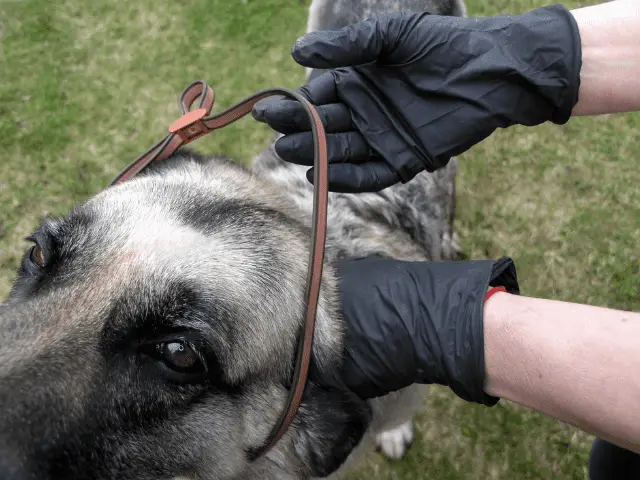Keeping ticks off your dog isn’t always easy, especially when you’re hiking in an area where ticks are prevalent. In some cases, Lyme disease and other tick borne diseases can be transmitted from a tick bite, which is why it’s so important to keep your dog protected from this type of parasite.
In this article we will discuss how you can prevent tick bites on your dog and keep them safe while enjoying the great outdoors. There are several different tick prevention options that you can choose from: Shampoo, Collars, Spray, Tablets
Types of Tick Preventative
There are many different products on the market that can help you to prevent ticks. Some are topical and others are oral. You should determine which type is best for your dog with your veterinarian before you start using it.
If your dog is in a high-risk tick area, or if they love to be in wooded areas, then you may want to try a product that will not only kill adult ticks, but also larvae and eggs found in your grass.
Fleas, of course, can also be a problem for dogs, especially in hot and humid areas. You may want to consider an option that will kill ticks and fleas on your dog within 24 hours of administering them.
It is important to understand that in order to keep ticks off your dog you need to consistently use a flea and tick prevention. If you stop using it for even a short period of time, ticks can quickly start to build up on your dog’s skin.
It’s important to know that many tick borne diseases, like Lyme disease and the potentially deadly rocky mountain spotted fever, can effect humans as well. And while diseases can’t be spread directly from your dog to you, ticks can hitch a ride home on your companion making you susceptible to a tick bite after your hike is over.
If your dog is not good at taking pills or tabs, then consider an external topical treatment or a collar. Your vet may also have alternatives for you to try.
Shampoo to Keep Ticks Off Your Dog

Most shampoos for ticks are designed to kill ticks that have already gotten onto your dog’s skin. They can help remove any small ticks that you can’t see with your eyes.
Some, however, say that they can help prevent re-infestation for a short period of time. You shouldn’t use a shampoo as your primary defense against ticks, however they can help if you believe your dog may have gotten into a tick nest and may have ticks too small for you to see.
Tick shampoos often contain insecticides, such as permethrin or imidacloprid. These chemicals are usually pretty safe for dogs, but make sure you don’t get any in your dog’s eyes.
If you don’t want to use a tick shampoo, feel free to lather your dog down with regular pet shampoo. It will clean off a lot of dirt and oil that might make your pup more appealing to ticks, not to mention getting rid of any insects already on your dog! Just make sure you rinse it all off thoroughly!
Using a Tick Spray on Your Dog
A topical spray that you put on your dog’s back is another effective tick repellent. The products typically kill both fleas and ticks and are waterproof for several hours, so you don’t have to worry about rain or swimming.
Some tick sprays are also safe for cats (but not humans), which means multiple-pet households can use it without having to buy separate products for each animal. Ticks can transfer to your other pets if they are brought home after hiking.
Some tick sprays can be used on dogs as young as seven weeks old. Your vet can recommend a tick spray for your dog based on their age and other health conditions.
Collar to Repel Ticks From Your Dog

Another option to prevent ticks is a tick collar, which provides continuous protection from fleas and ticks throughout the entire tick season. If you’re hiking with your dog in areas where ticks live, using a tick collar is one way to keep them off your pet.
Tick collars have proven to be very effective tick repellent for ticks and fleas. These collars cover their necks and release special chemicals into your dog’s coat that repel fleas and ticks.
As long as you put on a new tick collar at the suggested intervals, you will significantly reduce your pet’s chances of getting fleas or ticks while hiking. If your dog has allergies, be sure to get an allergen-free collar. Talk to your vet if you think your dog may be allergic to their tick collar.
The most common disadvantage of tick collars is that you must remove them before bathing your dog so they don’t fall off in the water. They should not come into contact with insecticides because these can cause irritation or other health problems for your pet.
Edible Tablet Tick Preventative for Your Dog
Oral (tablet) tick prevention works to prevent ticks by releasing an active ingredient that repels ticks, fleas, and even mosquitoes over a month-long period. This can be really useful if you are planning long hikes in wooded areas where tick encounters are more likely to occur.
The tablet can also be used with a spot-on treatment as part of a comprehensive protection strategy as it cannot provide protection against all parasites.
In fact, there’s no tick product on the market that will protect against all ticks.
Talk with your vet about using a spray in addition to your dog’s oral medication for tick prevention. Some medications may conflict. Talking with your vet before combining preventatives is imperative to making sure your dog stays safe.
Oral tick preventatives are easy to administer to your dog since they can be fed like a treat or with your dog’s meal. The dosage depends on your dog’s weight and can be given every two or four weeks according to a schedule that is printed on the product packaging.
As always, consult with your veterinarian if you are unsure how much or how to administer a tick preventative.
Check the Hot Spots for Ticks

The area on a dog’s back, between its shoulder blades, is a common hot spot for ticks. However, ticks are typically found anywhere on a dog’s body including their face and paws.
Just like with people, ticks are typically found on dogs in small crevices. That means checking under your dog’s ears, behind its neck, and in its armpits as well as on its hindquarters and tail.
If you think you see a tick on your dog, use tweezers to remove the full tick as soon as possible. If a tick is attached to a piece of loose skin that pulls away from the dog’s body, it can cause pain for your dog. Be careful when removing ticks from sensitive areas.
Once removed or detached, place any ticks into rubbing alcohol or other disinfectants immediately so they don’t get back onto your dog or spread any diseases elsewhere. Also, make sure to wash your hands thoroughly.
Final Thoughts
You can work with your veterinarian to come up with a tick defense strategy that works for you and your dog. There are many different types of tick preventatives, some may work better than others for your dog.
Learn more about checking your dog for ticks before, during, and after a hike as well as how to remove ticks after a hike.
